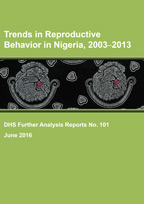There is no printed copy available to order.
Abstract:
This study is based on three Demographic and
Health Surveys conducted in Nigeria, in 2003,
2008, and 2013. The study was undertaken
against the background of a persistently high
rate of population growth in Nigeria, caused
primarily by a high fertility rate that has
shown few signs of decline. The United
Nations medium population projection for
Nigeria shows an increase from 282 million in
2015 to about 400 million by 2050, even with
an assumed substantial decline in fertility.
The present analysis explores the components
and some of the covariates of fertility in
Nigeria, recent trends, and potential future
changes. One objective is to assess the
extent to which various components of
reproduction and their changes in Nigeria
since 2003 can be explained at the macro
level of the country’s 37 states as well as
at the individual level. Trends in age at
marriage, reproductive preferences,
contraceptive use, teenage fertility, child
mortality, and total fertility are described.
The covariates of these reproductive
components highlight the importance of
women’s education, child mortality, monogamy,
religion, and exposure to television and
radio. Residence in the South of Nigeria is
consistently associated with lower fertility.
The most important determinants of fertility
decline in Nigeria are increases in women’s
education and decreases in child mortality.
However, while declines in child mortality in
recent years have been considerable, they
have not yet translated into substantial
declines in fertility, and increases in
women’s education have been very slow.
 Trends in Reproductive Behavior in Nigeria, 2003-2013 (PDF, 1495K)
Trends in Reproductive Behavior in Nigeria, 2003-2013 (PDF, 1495K)
